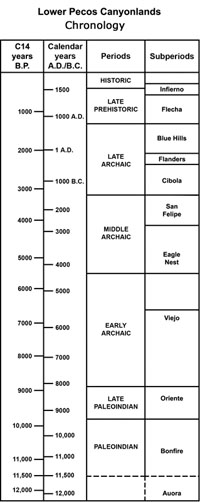Lower Pecos Canyonlands Prehistory
The Lower Pecos Canyonlands began attracting archeological attention in the 1930s when word of the wealth of perishable artifacts in the dry rockshelters spread among museums and research institutions in Texas and the nation. The world-class rock art also began attracting serious attention at about the same time, as epitomized by the work of artist Forrest Kirkland (see biographical sketch).
The Lower Pecos area is generally considered to be a distinct archeological region, but its prehistory has much in common with that of the adjacent Edwards Plateau and northern Coahuila (Mexico). These similarities have been obscured because of different preservation conditions across the wetter Edwards Plateau and because of the general dearth of archeological research in Coahuila.
A good introduction to the Lower Pecos Canyonlands can be found in a separate TBH exhibit (see Lower Pecos). Briefly, the area is defined by the junctions of the Pecos and Devils Rivers with the Rio Grande just upstream from Del Rio, Texas. The three rivers and their many tributaries form deeply incised canyons within which numerous rockshelters occur. Although the region is arid, averaging less than 15 inches of rain per year, the rivers as well as springs and temporary waterholes called tinajas within the smaller canyons provided reliable water sources.
For over 13,000 years hunter-gatherers lived in the region, sometimes occupying the rockshelters. The generally dry conditions coupled with the protected rockshelters resulted in the preservation of fragile materials such as wooden artifacts, woven sandals, and plant food refuse that decay quickly in most other areas of Texas. The spectacular rock art that abounds in the Lower Pecos Canyonlands gives researchers insight into aspects of human behavior—ritual, religion, mythology—that are all but impossible to study at most sites across the Edwards Plateau. For details, follow the above link and download the below article.
Turpin, Solveig A.
2004 The Lower Pecos River Region of Texas and Northern Mexico,
in The Prehistory of Texas, edited by Timothy K. Perttula, Texas
A&M University Press. [Slightly revised version of 1995 article by
the same name that appeared in the Bulletin of Texas Archeological Society
66: 541-560.]
Download Turpin 2004 PDF file.
